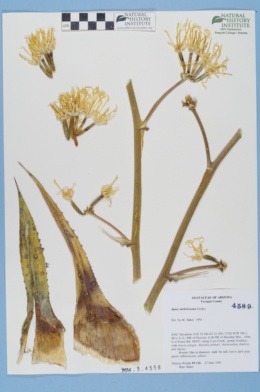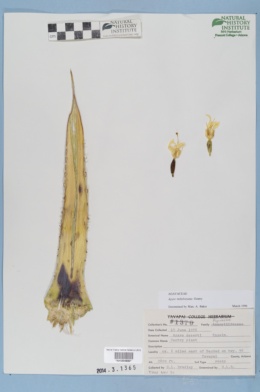Agave mckelveyana
|
|
|
|
Family: Asparagaceae
Mckelvey agave, more...McKelvey's Century-Plant, McKelvey's century plant
|
Plants acaulescent, solitary or sparsely suckering; rosettes 2-4.5 × 3-6 dm, rather open. Leaves spreading, broadest at middle, 17.5-40 × 2.8-5 cm; blade light glaucous green or yellowish green to dark green, usually cross-zoned, linear-lanceolate to lanceolate, rigid, adaxially concave, abaxially convex; margins straight or undulate to crenate, armed, teeth single, firmly attached, well defined, 4-8 mm, 1-3 cm apart; apical spine reddish brown to gray, subulate, 1.5-4 cm. Scape 2-5 m. Inflorescences paniculate, not bulbiferous, open; bracts persistent, triangular, 0.5-2 cm; lateral branches 10-19, ascending, comprising distal (1/4-)1/3-1/2 of inflorescence, longer than 10 cm. Flowers 6-12 per cluster, erect, 3-4 cm; perianth light yellow, tube shallow, broadly campanulate, 2-4.5 × 8-10.5(-18) mm, limb lobes wilting soon after anthesis, spreading, equal or subequal, 11-13 mm; stamens long-exserted; filaments inserted near or at top of perianth tube, erect, yellow, 2.5-3.3 cm; anthers yellow, (7-)9-16 mm; ovary 1.6-2.2 cm, neck slightly constricted, 1-2.5 mm. Capsules short-pedicellate, narrowly oblong to oblong, 3-4.5 cm, apex beaked. Seeds 5-6.5 mm. Flowering mid spring--mid summer. Sandy to gravelly or rocky places with desert scrub, chaparral and pinyon-juniper woodlands; 800--2200 m; Ariz. Agave mckelveyana may hybridize with A. deserti var. simplex and A. utahensis var. utahensis in Arizona.
Plant: Perennial scapose herb; -Rosettes 20-45 cm tall, single or caespitose, open Leaves: few, 17.5-40 cm long, 2.8-5 cm wide, linear or lanceolate, broadest in the middle, acuminate, convex towards apex, thickish and deeply concave towards base, rigid, firm, spreading to ascending, light glaucous green, yellow-green to dark green, usually with light cross-zoned patterns; margins nearly straight or undulate; teeth mostly 4-8 mm long at mid-blade, flexed upward or downward, mostly 1-3 cm apart, grayish with red-brown tips, sometimes with brown ring at base; interstitial teeth absent; terminal spine 1.5-4 cm long, subulate, with shallow open groove at base, decurrent to first or second teeth, gray INFLORESCENCE: narrowly paniculate, with scape 2-5 m tall, of 10-19 lateral ascending branchlets in upper ½ of flowering stalk, the stalk slender, green Flowers: in small congested clusters, 30-40 mm long; tepals spreading, soon wilting after anthesis, equal to subequal, 11-13 mm long, 2.5-4 mm wide, linear conduplicate, abruptly hooded at tips, yellow; filaments 25-30 mm long, inserted near or at top of tube, light yellow, the anthers (7-)9-16 mm long, yellow; ovary 16-22 mm long, stoutish, with constricted neck 2-2.5 mm long, light green to green, the style 25-38 mm long when stigma is receptive; floral tube shallow, open, 2-4.5 mm long, 8-10 mm broad, light green to light yellow Fruit: a loculicidal capsule, CAPSULES linear to oblong, 30-45 mm long, 10-14 mm wide, stipitate, obtuse to apiculate, striate; SEEDS black, 5-6.5 mm long, 4-4.5 mm broad Misc: Open rocky slopes in upper desert scrub, chaparral and juniper woodland; 850-2200 m (2800-7200 ft); May-Jul REFERENCES: Hodgson, Wendy. 1999. Agavaceae. Ariz. - Nev. Acad. Sci. 32(1). |



























































































